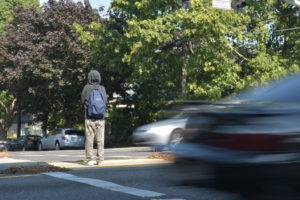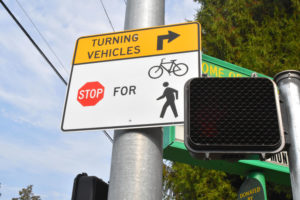Making Powell Safe
It took a tragedy to force officials to confront the fact that Powell is not safe. Cleveland and the local community tells transportation officials and legislators it has had enough and wants change at an emotionally charged public hearing
Clarion photo Minying Zhen
Cleveland students cross Powell at 26th Ave. in front of the school.
The overall feel in the auditorium on Oct. 20 was somber, quiet. Close to a quarter of the seats were filled with a collection of Portlanders – bikers, students, concerned parents and Cleveland teachers, and survivors of near-fatal bike crashes – all there to share their opinion on the matter.
A panel of state and local officials presented plans for Powell Boulevard. Attending were Margaret Clavert, assistant superintendent of Portland Public School; Chris Warner, director of Portland Bureau of Transportation (PBOT); Kris Strickler, director of Oregon Department of Transportation (ODOT), and Sam Desue Jr., a general manager at TriMet.
State Senator Kathleen Taylor, representing Portland’s District 21, started the forum by acknowledging the staggering number of people who fall victim to fatal collisions while walking and biking in Portland. She asked for a moment of silence for the late Sarah Pliner, who was hit and killed on Powell Boulevard on Oct. 4. The crowd, already silent, ceased all movement, heads hung low as the minute stretched on.
“This isn’t about politicians, and telling you everything is okay. People want to know what is going to be done to make Portland safer,” Taylor said.
Kiel Johnson, chair of the non-profit BikeLoud PDX, spoke first. Last year Portland saw the most traffic-related deaths on ODOT-managed roads in the past 30 years, he said, noting just how many people cross Powell daily as bikers, children, and disabled individuals.
“We protested a few years ago for green bike boxes to be repainted on 26th, which make it apparent there are often bikers turning or crossing. ODOT had removed them. There used to be a school speed zone, but ODOT removed that. There are not a lot of human crosswalk signs [along Powell]. They have moved major bikeways to less convenient streets. ODOT only designs roads and crosswalks for cars and commercial vehicles, and Sarah paid the price for those choices,” Johnson said. “People deserve to be safe no matter how they get around,” Johnson concluded, to which the crowd erupted in applause.
The Panels Plans for Powell:
Strickler, the director of ODOT, said that Powell Boulevard was originally designed as a state highway, but as neighborhoods and schools continue to sprout up around it, the roadway must change to fit the needs.
Just a few days before the forum, ODOT established the area around Cleveland as a school speed zone and lowered speeds to 20 mph on Powell and 26th in the window of- 7 a.m. to 5 p.m.
Other immediate plans include temporary speed feedback signs, tree trimming, high visibility crosswalks, and striping on corners, which is already completed on the 26th and Powell intersection. Additionally ODOT plans to change the crosswalk system to have a leading pedestrian interval, allowing pedestrians to walk before the light turns green for vehicles, Strickler said.
Long-term action by ODOT includes installing photo radar to encourage lower speeds, permanent speed feedback signs, and striping more than 20 intersections stretching from 8th to 88th and Powell. Expected timelines for these actions range from one month to a year, Strickler said, adding that Covid-19-related supply chain issues may be a roadblock.
Strickler’s slides showed the new striping near the southeastern most corner – to encourage slower turns, when a member of the audience, Hami Ramani, interrupted with a shout.
“Is that where she died?” he called out, and the panel and audience went silent.
“Do you really think that is going to prevent other people from being killed?” Ramani finished.
Sen. Taylor jumped in, silencing the stirring audience, and said the time for questions was later. Ramani apologized and settled down, but quiet scoffs and disapproval continued to come from his direction.
Warner, the director of the Portland Bureau of Transportation (PBOT), said that Portland became a vision zero city in 2015. This initiative was to establish safer roads through many of the same ways that Powell will be improved – tree trimming, pedestrian head starts, and heavy truck side guards.
“We have a system designed for cars, but we need a system for everyone, and we are trying to do so,” Warner said.
Many of PBOT’s plans are similar to or in conjunction with ODOT.
PBOT has already accomplished striping crosswalks, installing a school speed zone (signs), and tightening the radius around the southeast corner. Their plans include adding back the green bike boxes and creating green bike lanes with buffers on 26th. Long-term plans include building elevated bike lanes on 26th to increase separation, upgrading signs, and most notably creating a crosswalk with a refuge island directly in front of Cleveland’s entrance.
Tom Mills, director of planning and policy at TriMet, talked about the possibility of changing bus routes due to the sheer number of students who cross Powell to get to or have bus stops near Powell. Mills also brought up the mass of students who pour directly onto 26th at bell times to catch or get off line 10. A few weeks after Pliner’s death, a student was hit and minorly injured by a car while they were running to catch a bus. TriMet is searching for remedies to this growing concern, Mills said.
For stops such as lines 9 and 75 on the southwest corner of Powell and 26th, they plan to push the stops back, away from the intersection. For other stops, there are several plans for completely rerouting to reduce trips across Powell. Specifically for line 70, transporting students from Ladd’s Addition and beyond, there are two options for route changes.
One change would cut through Ladd’s Addition and drop off on 26th near line 10. This would reduce students’ trips across Powell from that particular neighborhood from two down to zero. The other change would drop students off at Tibbetts and 21st, two blocks away from Cleveland, eliminating the event of students running across 26th in the middle of the road as they do for line 10 currently.
Margaret Calvert, assistant superintendent of PPS, was the last of the panel to talk. She started her presentation with a word from Superintendent Guadalupe Guerrero, who wanted to come but was unable.
“Our students deserve routes to our schools that are safe. We are thankful to have this opportunity to converse and take concrete steps to change. We need to recognize that students walk and cross Powell, near 4 schools – 2500 students cross these streets multiple times a day,” Guerrero said.
Calvert has been actively working with PBOT for the last two decades on making getting to school easy and safe. She remarked that PPS has approached many schools about encouraging students to walk and bike but also teaching biker and pedestrian safety. Again, working in conjunction with PBOT to lower speeds around schools. They have been focusing primarily on elementary and middle school, but will be expanding to high schools.
Question and Answer session:
The Q&A session was emotionally charged in every possible way. Some people came up and had the audience on the verge of tears, and others had them on the edge of their seats, shouting. It was tense and thick. The audience would almost hold a collective breath every time a new person made their way up to the makeshift podium.
Molly Swanson was the first to speak. Her son regularly bikes to school at Cleveland and she mentioned how a while back her son had voiced his fear and worries about someone getting injured on Powell while crossing. Then someone got killed, affirming her’s and other parents’ worries about their child’s commute to school.
Swanson then brought up the concept of a pedestrian scramble, which has been implemented in major cities such as Boston, Ohio, New York, and Washington D.C. The system provides an entire light cycle just for pedestrians, which would make it easier to cross from Cleveland to Powell Park in less than the usual five minutes.
The pedestrian scramble system was brought up many times by different individuals including Maggie, [last name unknown], a parent of a Cleveland freshman.
PBOT’s Warner answered Maggie’s questions in a deflective manner, saying that he didn’t want to get into the mathematics behind installing the pedestrian scramble. Additionally, he mentioned that a system like this has never been asked of his department before. Cleveland science teacher Meg Griffith called out from the audience and said that Cleveland had requested the pedestrian scrabble or like-system for a while.
Owl Brook, a Cleveland freshman, stepped up to the mic. The air was instantly sucked out of the auditorium. Brook witnessed the horrific event firsthand on their way back from Powell Park. Brook mentioned that most adults don’t often witness death that isn’t expected, and that as a 14-year-old, they will always have to carry the weight of Sarah Pliner’s death.
“Something needs to change, something needs to happen. Please, I am so appreciative of all that you are doing, but please,” Brook said, referring to the safety of people on Powell.
Soon after, Susan Beal, mother of a Cleveland freshman, shared her child’s story. Owl Brooks and Beal’s child were waiting to cross together at the time of the accident. Beal started by extending a thank you to Cleveland staff for all they had done the day of Pliner’s death. A Cleveland teacher had held Beal’s child’s hand and helped them across the street because they didn’t want to open their eyes again. She also mentioned that there was a teacher or staff member that had performed CPR on Pliner, holding out hope, until the ambulance arrived.
Alex Fuller, an environmental systems and societies and physics teacher at Cleveland High School, stepped up next. He said that Oct. 4 was one of the hardest days he’s had in his 10 years of teaching. His class was supposed to go on a walking field trip to Holgate Boulevard to place particulate detectors to evaluate the impact of truck driving in and out of the Brooklyn Rail Yard; they were not able to leave the building.
“When I was finally able to pull myself together enough to stand in the front of the class, I had to explain to them, with tears in my eyes, that particulate pollution was not the only impact of heavy truck driving on our community. I care deeply for our students and want them to be safe at school and in the neighborhood,” Fuller said, and the audience clapped loudly.
Hami Ramani made a bold statement for his question. He held a framed picture with the word “love,” thrust it to the sky and faced the audience.
“What does this mean to you? Do you feel this on our streets?” Ramani asked. “I think it’s a resounding no,” he shouted, voice sharp and chastising. He continued to talk about compassion and reallocating the money set aside for highway expansion and putting it towards “our streets … for the people!” he called out.
The consensus of the Q&A session was, for the most part, in favor of making major changes to Powell. A mother of a Creston elementary student asked that the crosswalk striping project be extended to 52nd, which would create a continuous line of safety measures on Powell. A former Cleveland parent brought up improving facilities for bikes on 21st to encourage biking commuters to take that route, because the current neighborhood greenway on 28th is extremely narrow, and 26th is still lacking actual bike lanes.
But an overwhelming number of people asking questions mentioned lane reallocation, meaning downsizing the number of lanes on Powell Boulevard. Many individuals brought up the horrifying fact that on major roadways, often not all lanes stop for pedestrians or bikers. A mother from earlier, Maggie’s college-aged son was hit and seriously injured a few years ago due to the third lane of traffic not stopping. He is still at home recovering from the injuries.
Shawn [last name unknown] was the only person to bring up a counterpoint to lane reallocation. He brought up the fact that if lanes were cut off of Powell it would cause a massive problem seeing that it is a major artery for Portland traffic.
“I want to see a bike deliver pallets,” he said, touching on the idea that trucking and freight hauling is necessary for the city’s infrastructure. He continued to say that the people who use streets like Powell for transportation, whose businesses need the major intersections, aren’t the ones who bike.
There was a massive outcry from the audience: anger and disagreement shot across the room. Sen. Taylor had to actively take the mic and ask for silence. Taylor then said if anyone had something to say, they needed to get in line and wait their turn.
Results:
Many more people came up to the podium, voicing their opinions, sharing their stories, and asking, pleading for change. For the most part, the forum was positive. PBOT, ODOT, TriMet, and PPS outlined notable improvements, photo radar, bus route changes, reinstalling bike boxes, additional crosswalks, and continuing to connect with the community. And the power of the Cleveland community can be seen as you cross Powell on the newly-painted crosswalks, which are only the beginning of the positive change.
If you have anything you would like share about the accident, concerns, questions, solutions:
TriMet:
[email protected]
Portland Bureau of Transportation:
www.portland.gov/transportation
PBOT’s safe routes to school program:
www.portland.gov/safe-routes
Oregon Department of Transportation:
https://highway.odot.state.or.us/cf/comments/comments.cfm
Portland Public Schools:
https://www.pps.net/contact
My name is Min, and I'm a Junior at Cleveland. This is my second year on the Clarion, and I'm the Clarion photography editor. Woohoo!










